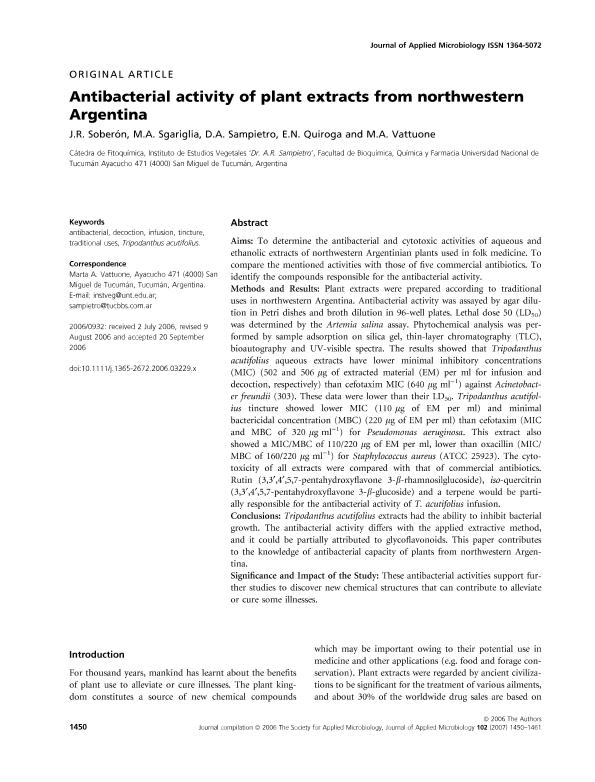Artículo
Antibacterial activity of plant extracts from northwestern Argentina
Soberon, Jose Rodolfo ; Sgariglia, Melina Araceli
; Sgariglia, Melina Araceli ; Sampietro, Diego Alejandro
; Sampietro, Diego Alejandro ; Quiroga, Emma Nelly; Vattuone, Marta Amelia
; Quiroga, Emma Nelly; Vattuone, Marta Amelia
 ; Sgariglia, Melina Araceli
; Sgariglia, Melina Araceli ; Sampietro, Diego Alejandro
; Sampietro, Diego Alejandro ; Quiroga, Emma Nelly; Vattuone, Marta Amelia
; Quiroga, Emma Nelly; Vattuone, Marta Amelia
Fecha de publicación:
06/2007
Editorial:
Wiley Blackwell Publishing, Inc
Revista:
Journal of Applied Microbiology
ISSN:
1364-5072
Idioma:
Inglés
Tipo de recurso:
Artículo publicado
Clasificación temática:
Resumen
To determine the antibacterial and cytotoxic activities of aqueous and ethanolic extracts of northwestern Argentinian plants used in folk medicine. To compare the mentioned activities with those of five commercial antibiotics. To identify the compounds responsible for the antibacterial activity. Methods and Results: Plant extracts were prepared according to traditional uses in northwestern Argentina. Antibacterial activity was assayed by agar dilution in Petri dishes and broth dilution in 96-well plates. Lethal dose 50 (LD50) was determined by the Artemia salina assay. Phytochemical analysis was performed by sample adsorption on silica gel, thin-layer chromatography (TLC), bioautography and UV-visible spectra. The results showed that Tripodanthus acutifolius aqueous extracts have lower minimal inhibitory concentrations (MIC) (502 and 506 ìg of extracted material (EM) per ml for infusion and decoction, respectively) than cefotaxim MIC (640 ìg . ml-1) against Acinetobacter freundii (303). These data were lower than their LD50. Tripodanthus acutifolius tincture showed lower MIC (110 ìg of EM per ml) and minimal bactericidal concentration (MBC) (220 ìg of EM per ml) than cefotaxim (MIC and MBC of 320 ìg . ml-1) for Pseudomonas aeruginosa. This extract also showed a MIC/MBC of 110/220 ìg of EM per ml, lower than oxacillin (MIC/MBC of 160/220 ìg ml-1) for Staphylococcus aureus (ATCC 25923). The cytotoxicity of all extracts were compared with that of commercial antibiotics. Rutin (3,3´,4´,5,7-pentahydroxyflavone 3-â-rhamnosilglucoside), iso-quercitrin (3,3´,4´,5,7-pentahydroxyflavone 3- â -glucoside) and a terpene would be partially responsible for the antibacterial activity of T. acutifolius infusion. Conclusions: Tripodanthus acutifolius extracts had the ability to inhibit bacterial growth. The antibacterial activity differs with the applied extractive method, and it could be partially attributed to glycoflavonoids. This paper contributes to the knowledge of antibacterial capacity of plants from northwestern Argentina. Significance and Impact of the Study: These antibacterial activities support further studies to discover new chemical structures that can contribute to alleviate or cure some illnesses.
Palabras clave:
Antibacterial
,
Infusion
,
Traditional Uses
,
Tripodanthus Acutifolius
Archivos asociados
Licencia
Identificadores
Colecciones
Articulos(CCT - NOA SUR)
Articulos de CTRO.CIENTIFICO TECNOL.CONICET - NOA SUR
Articulos de CTRO.CIENTIFICO TECNOL.CONICET - NOA SUR
Citación
Soberon, Jose Rodolfo; Sgariglia, Melina Araceli; Sampietro, Diego Alejandro; Quiroga, Emma Nelly; Vattuone, Marta Amelia; Antibacterial activity of plant extracts from northwestern Argentina; Wiley Blackwell Publishing, Inc; Journal of Applied Microbiology; 102; 6; 6-2007; 1450-1461
Compartir
Altmétricas



